Sensor-Less Control of Mirror Manipulator Using Shape Memory Polyimide Composite Actuator: Experimental Work
Abstract
:1. Introduction
2. Design and Working Principle of the Mirror Manipulator
2.1. Schematic and Working Principle
2.2. Actuator of the Mirror Manipulator
3. System Identification and Displacement Estimation
4. Design of Controller
4.1. Tuning of Control Parameters
4.2. Control Strategy
4.2.1. Control of Y Manipulation
4.2.2. Control of θ Manipulation
5. Results and Discussion
5.1. Comparison of Performances with and without Control
5.2. Control Performances
5.2.1. Tracking Response of Pulse Trajectory
5.2.2. Tracking Response of Sine and Multistep Trajectory
5.2.3. Disturbance Rejection
6. Conclusions
Author Contributions
Funding
Institutional Review Board Statement
Informed Consent Statement
Data Availability Statement
Conflicts of Interest
References
- Seo, S.; Kang, M.; Han, M.W. Shape Memory Alloys Patches to Mimic Rolling, Sliding, and Spinning Movements of the Knee. Biomimetics 2024, 9, 255. [Google Scholar] [CrossRef] [PubMed]
- Zhu, Y.; Jia, Z.; Niu, X.; Dong, E. Design and Position Control of a Bionic Joint Actuated by Shape Memory Alloy Wires. Biomimetics 2024, 9, 210. [Google Scholar] [CrossRef] [PubMed]
- Patra, N.; Geetha, S.R.; Harish, C.; Chouhan, N.; Singh, V.; Palani, I.A. Compositional influence of CuAlMn SMA coated optical fiber towards sensing low temperature. Sens. Actuators A Phys. 2024, 366, 114997. [Google Scholar] [CrossRef]
- Muralidharan, M.; Saini, P.; Ameta, P.; Palani, I.A. Bio-inspired soft jellyfish robot: A novel polyimide-based structure actuated by shape memory alloy. Int. J. Intell. Robot. Appl. 2023, 7, 671–682. [Google Scholar] [CrossRef]
- Sibirev, A.V.; Alchibaev, M.V.; Belyaev, S.P.; Resnina, N.N.; Palani, I.A. Functional properties of NiTi/Kapton nanocomposites deposited by electronic beam evaporation. Lett. Mater. 2023, 13, 62–66. [Google Scholar] [CrossRef]
- Ma, J.; Zhu, R.M.; Lu, D.L.; Yin, T.; Zhong, M.C.; Wu, J.L.; Min, Y.G.; Lu, S.G. Experimental and Theoretical Studies of a Thermal Switch Based on Shape-Memory Alloy Cladded with Graphene Paper Part A Recover. Util. Environ. Eff. Energy Sources 2020, 42, 898–908. [Google Scholar] [CrossRef]
- Liu, Y.; Huang, X. Substrate-Induced Stress and Transformation Characteristics of a Deposited Ti-Ni-Cu Thin Film. Philos. Mag. 2004, 84, 1919–1936. [Google Scholar] [CrossRef]
- Ishida, A. Ti–Ni–Cu/polyimide composite-film actuator and simulation tool. Sens. Actuators A Phys. 2015, 222, 228–236. [Google Scholar] [CrossRef]
- Ishida, A.; Sato, M. Ti–Ni–Cu shape-memory alloy thin film formed on polyimide substrate. Thin Solid Films 2008, 516, 7836–7839. [Google Scholar] [CrossRef]
- Ishida, A.; Sato, M. Development of Polyimide/SMA Thin-Film Actuator. Mater. Sci. Forum 2010, 654–656, 2075–2078. [Google Scholar] [CrossRef]
- Kishi, Y.; Ikenaga, N.; Sakudo, N.; Yajima, Z. Shape memory behavior of TiNi alloy films sputter-deposited on polyimide substrate. J. Alloys Compd. 2013, 577, S210–S214. [Google Scholar] [CrossRef]
- Kotnur, V.G.; Tichelaar, F.D.; Fu, W.T.; De Hosson, J.T.; Janssen, G. Shape memory NiTi thin films deposited on polyimide at low temperature. Surf. Coat. Technol. 2014, 258, 1145–1151. [Google Scholar] [CrossRef]
- Kotnur, V.G.; Tichelaar, F.D.; Janssen, G.C.A.M. Sputter deposited NieTi thin films on polyimide substrate. Surf. Coat. Technol. 2013, 222, 44–47. [Google Scholar] [CrossRef]
- Dasgupta, R.; Jain, A.K.; Kumar, P.; Hussein, S.; Pandey, A. Effect of alloying constituents on the martensitic phase formation in some Cu-based SMAs. J. Mater. Res. Technol. 2014, 3, 264–273. [Google Scholar] [CrossRef]
- Shishkovsky, I.; Yadroitsev, I.; Morozov, Y. Laser-assisted synthesis in Cu-Al-Ni system and some of its properties. J. Alloys Compd. 2016, 658, 875–879. [Google Scholar] [CrossRef]
- Akash, K.; SS, M.P.; Shukla, A.K.; Nath, T.; Karthick, S.; Palani, I.A. Investigations on the life cycle behavior of Cu-Al-Ni/polyimide shape memory alloy bi-morph at varying substrate thickness and actuation conditions. Sens. Actuators A Phys. 2017, 254, 28–35. [Google Scholar] [CrossRef]
- Akash, K.; Shukla, A.K.; Prabu, S.S.; Narayane, D.C.; Kanmanisubbu, S.; Palani, I.A. Parametric investigations to enhance the thermomechanical properties of CuAlNi shape memory alloy Bi-morph. J. Alloys Compd. 2017, 720, 264–271. [Google Scholar] [CrossRef]
- Akash, K.; Chandan, K.; Parikshit, G.; Disawal, R.; Lad, B.K.; Singh, V.; Palani, I.A. Investigations on transformer oil temperature sensing using CuAlNi/polyimide shape memory alloy composite film. In Behavior and Mechanics of Multifunctional Materials and Composites 2017, Proceedings of the SPIE Smart Structures and Materials + Nondestructive Evaluation and Health Monitoring, Portland, OR, USA, 25–29 March 2017; SPIE: Bellingham, WA, USA, 2017; Volume 10165. [Google Scholar] [CrossRef]
- Akash, K.; Jain, A.K.; Karmarkar, G.; Jadhav, A.; Narayane, D.C.; Patra, N.; Palani, I.A. Investigations on actuation characteristics and life cycle behaviour of CuAlNiMn shape memory alloy bimorph towards flappers for aerial robots. Mater. Des. 2018, 144, 64–71. [Google Scholar] [CrossRef]
- Jayachandran, S.; Akash, K.; Prabu, S.S.; Manikandan, M.; Muralidharan, M.; Brolin, A.; Palani, I.A. Investigations on performance viability of NiTi, NiTiCu, CuAlNi and CuAlNiMn shape memory alloy/Kapton composite thin film for actuator application. Compos. Part B Eng. 2019, 176, 107182. [Google Scholar] [CrossRef]
- Durante, F.; Raparelli, T.; Zobel, P.B. Resistance Feedback of a Ni-Ti Alloy Actuator at Room Temperature in Still Air. Micromachines 2024, 15, 545. [Google Scholar] [CrossRef]
- Lambert, T.R.; Gurley, A.; Beale, D. SMA actuator material model with self-sensing and sliding-mode control; experiment and multibody dynamics model. Smart Mater. Struct. 2017, 26, 035004. [Google Scholar] [CrossRef]
- Zhang, J.-J.; Yin, Y.-H.; Zhu, J.-Y. Electrical Resistivity-Based Study of Self-Sensing Properties for Shape Memory Alloy-Actuated Artificial Muscle. Sensors 2013, 13, 12958–12974. [Google Scholar] [CrossRef] [PubMed]
- Chaitanya, S.K.; Dhanalakshmi, K. Control of shape memory alloy actuated gripper using sliding mode control. In Proceedings of the IEEE International Conference on Control Applications (CCA), Hyderabad, India, 28–30 August 2013; pp. 1247–1252. [Google Scholar]

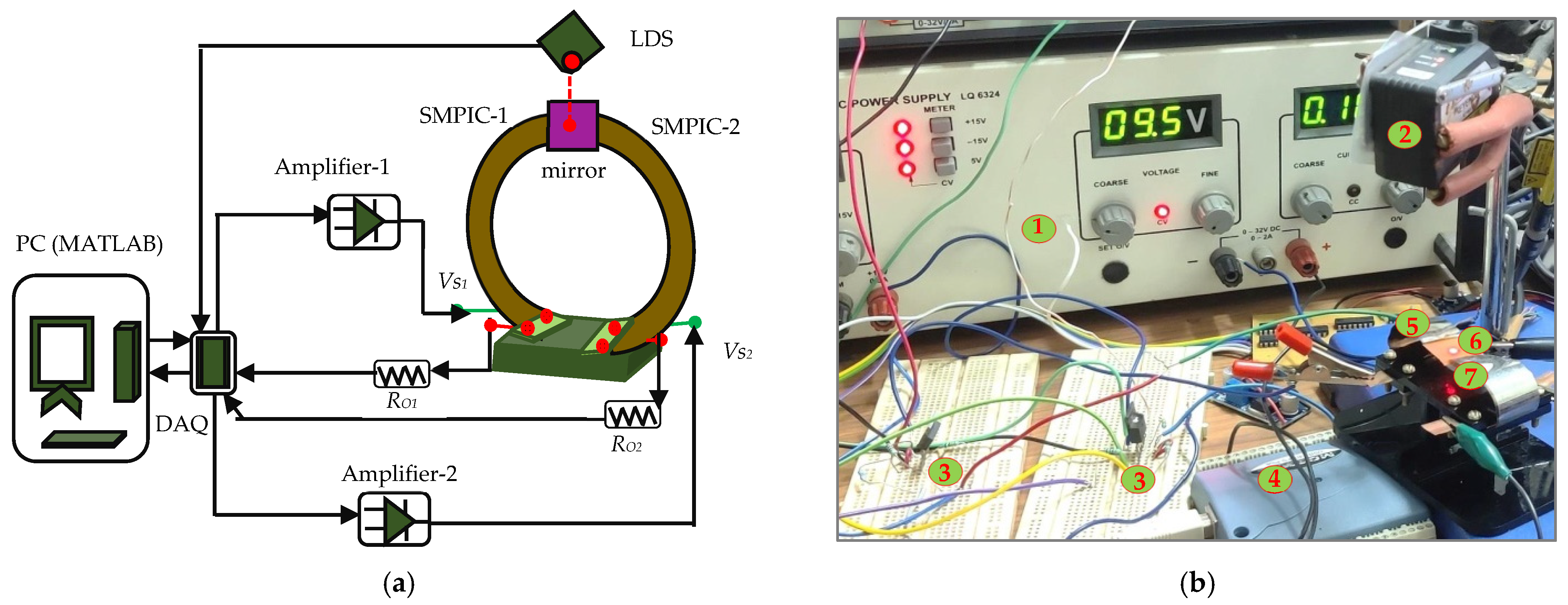
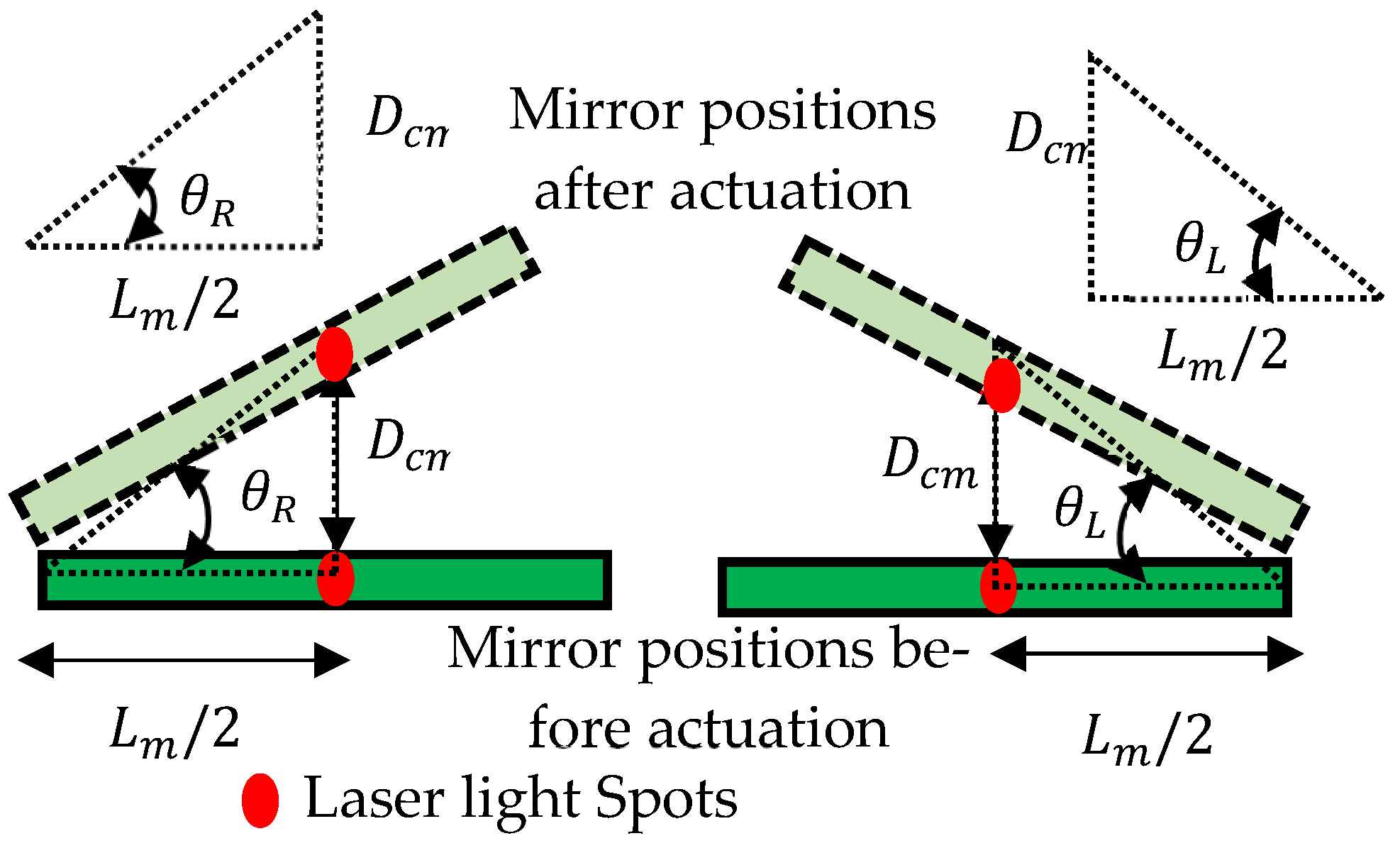
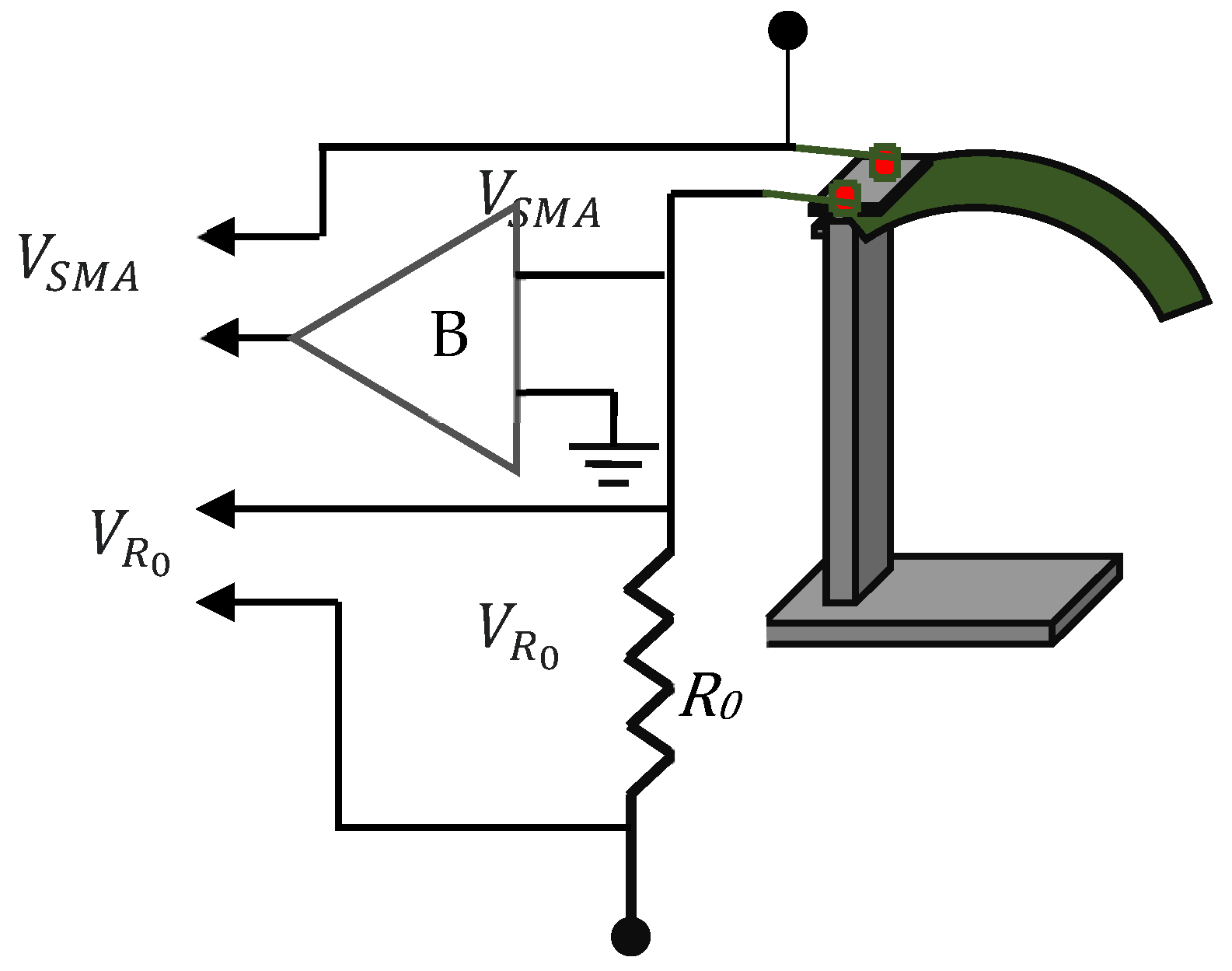
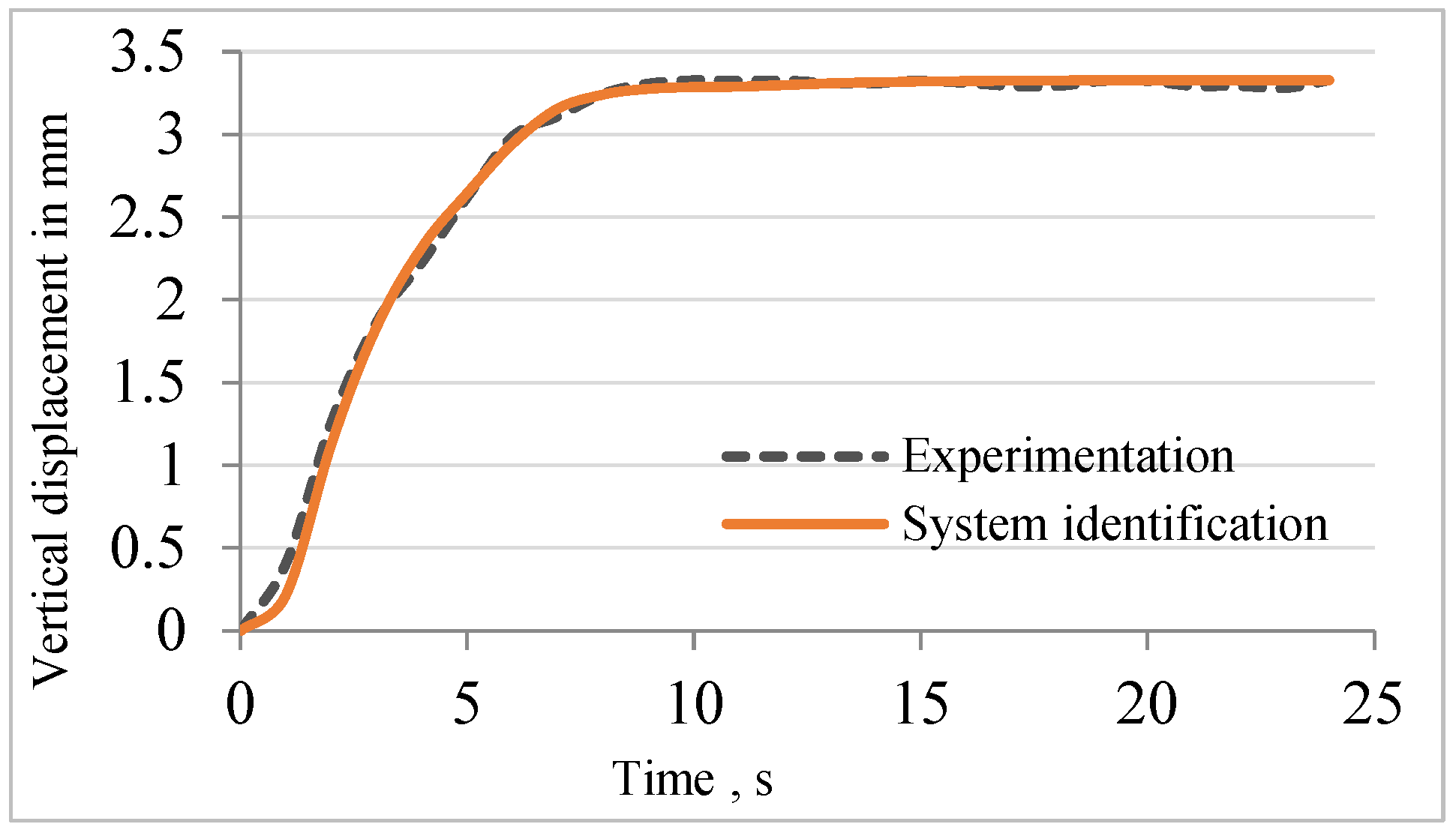



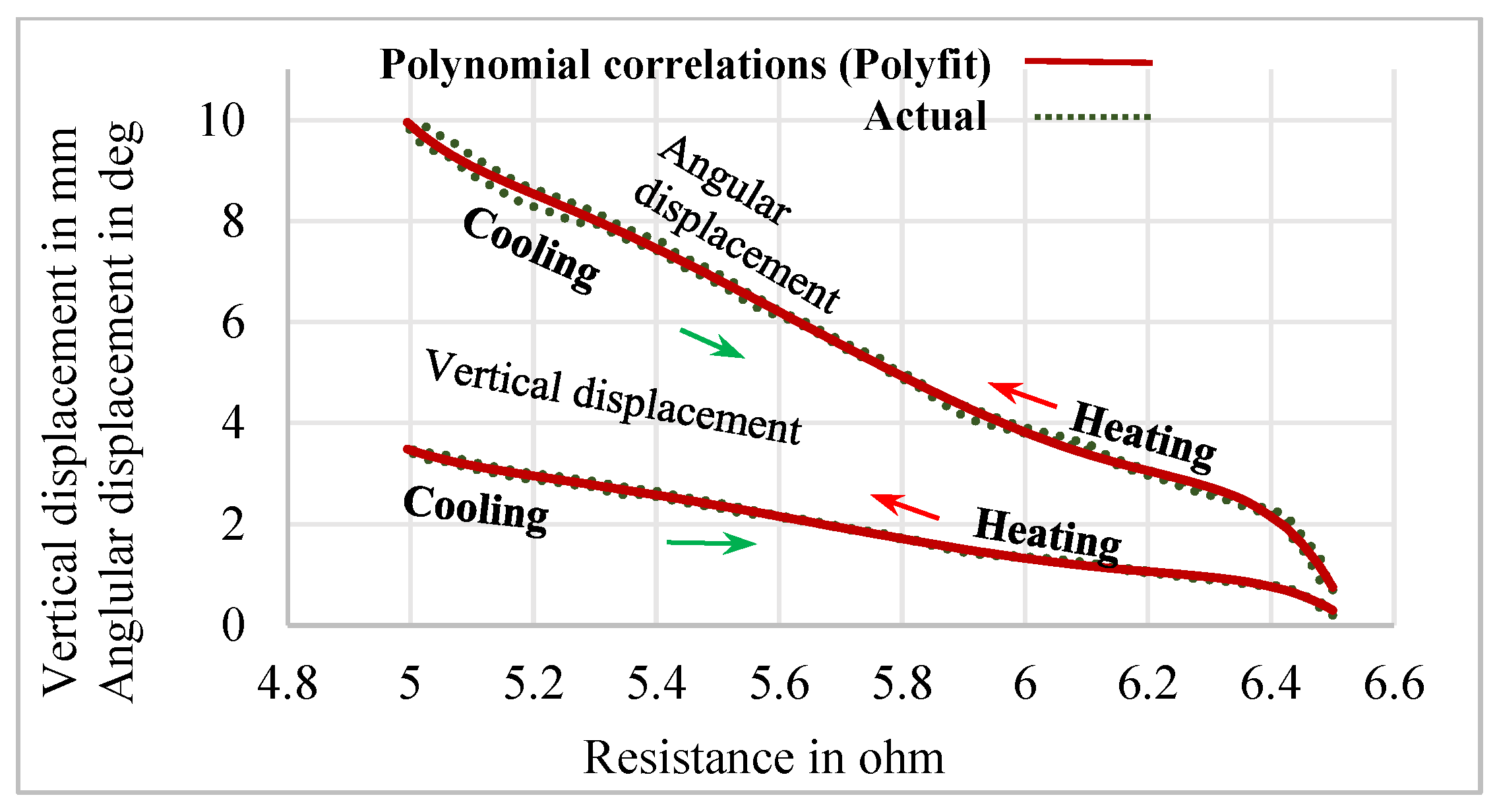


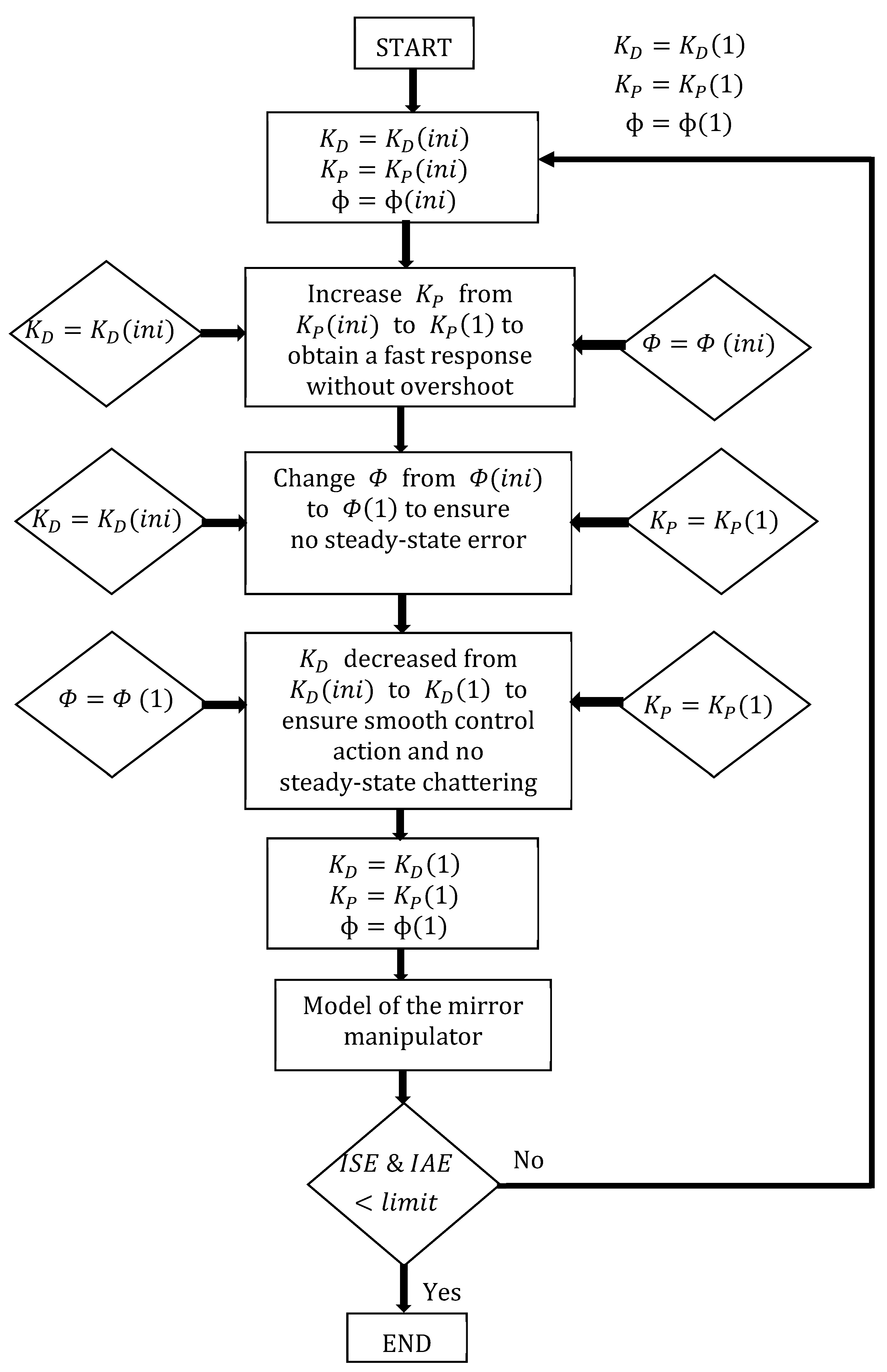
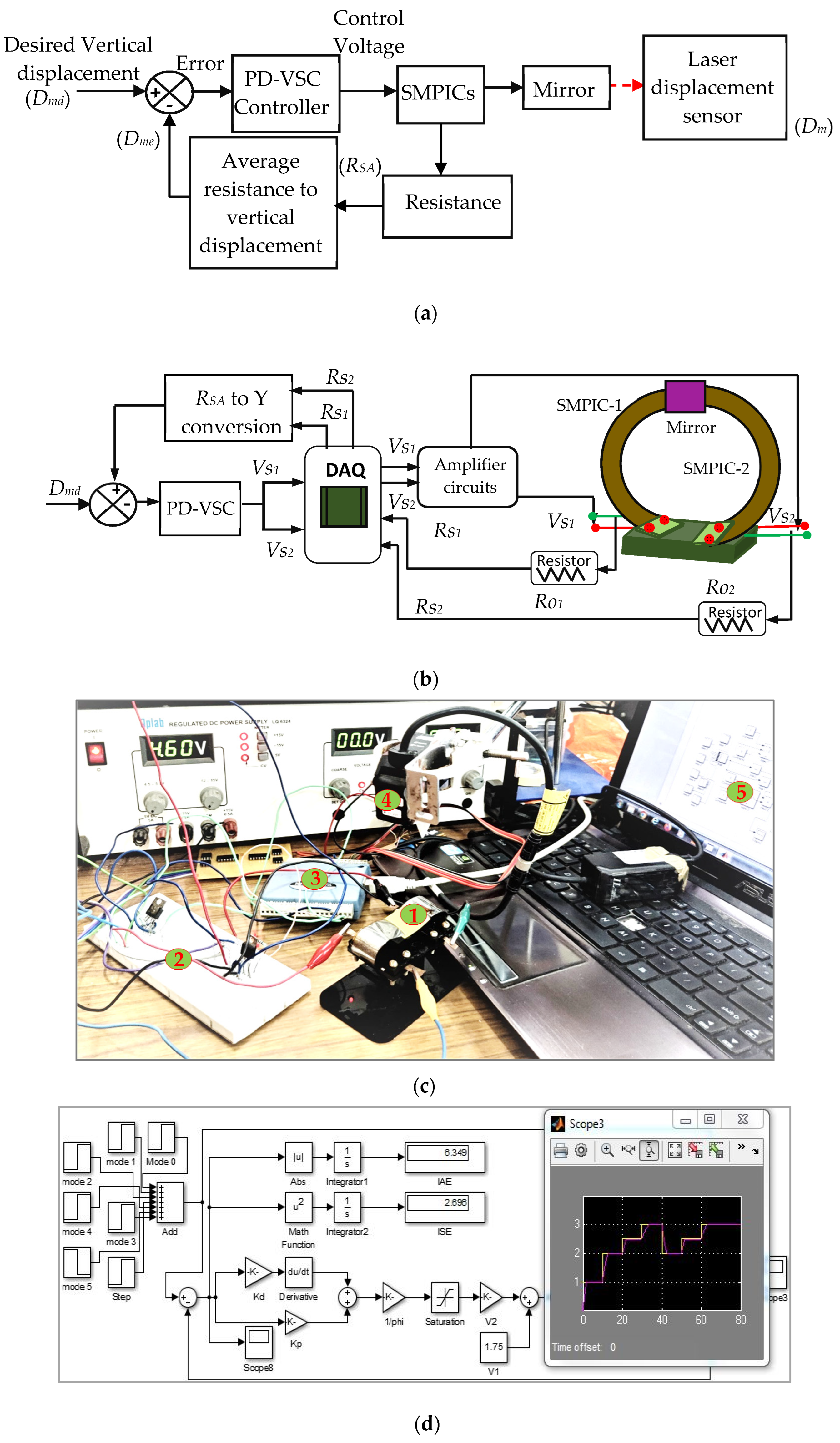
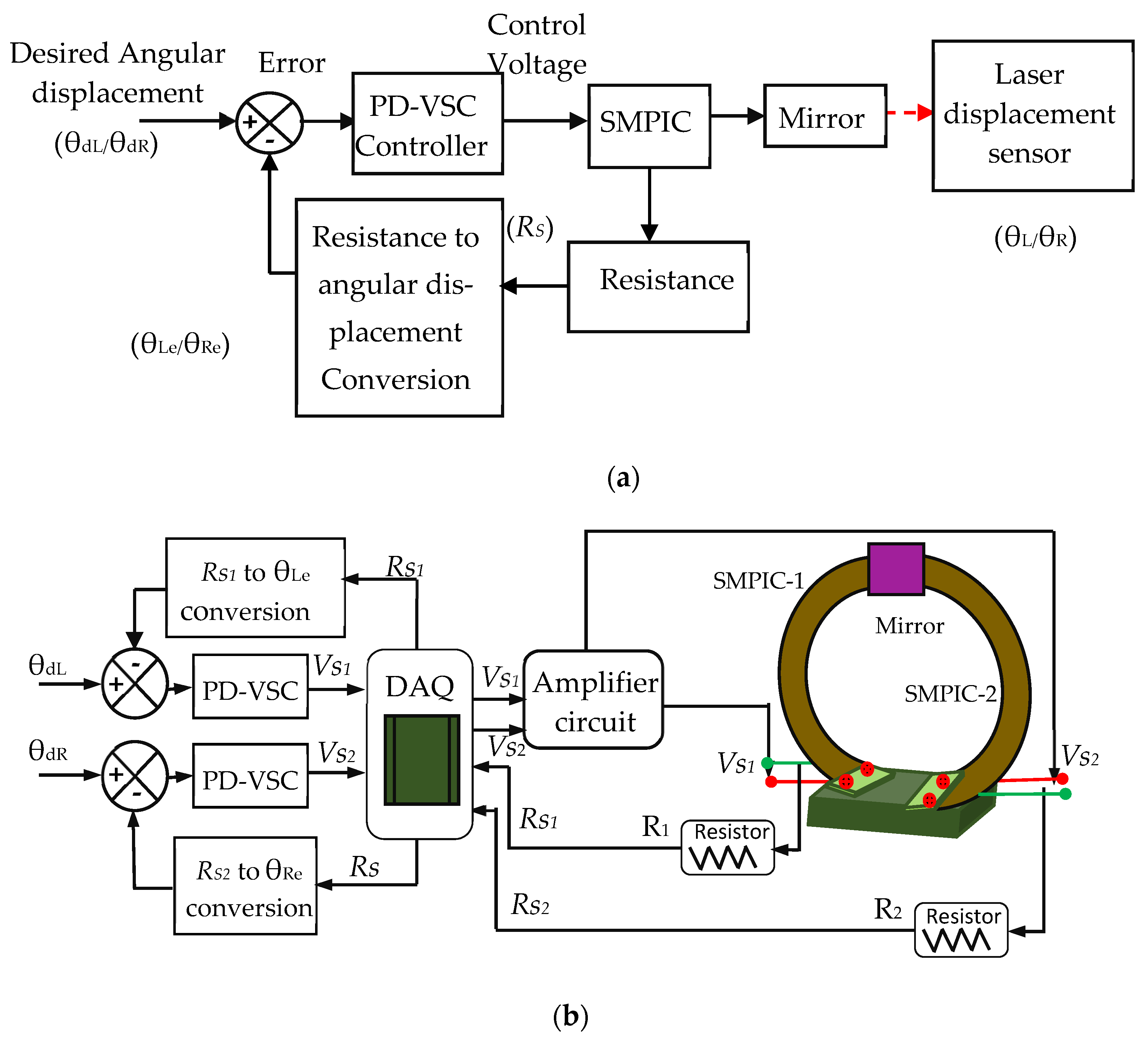

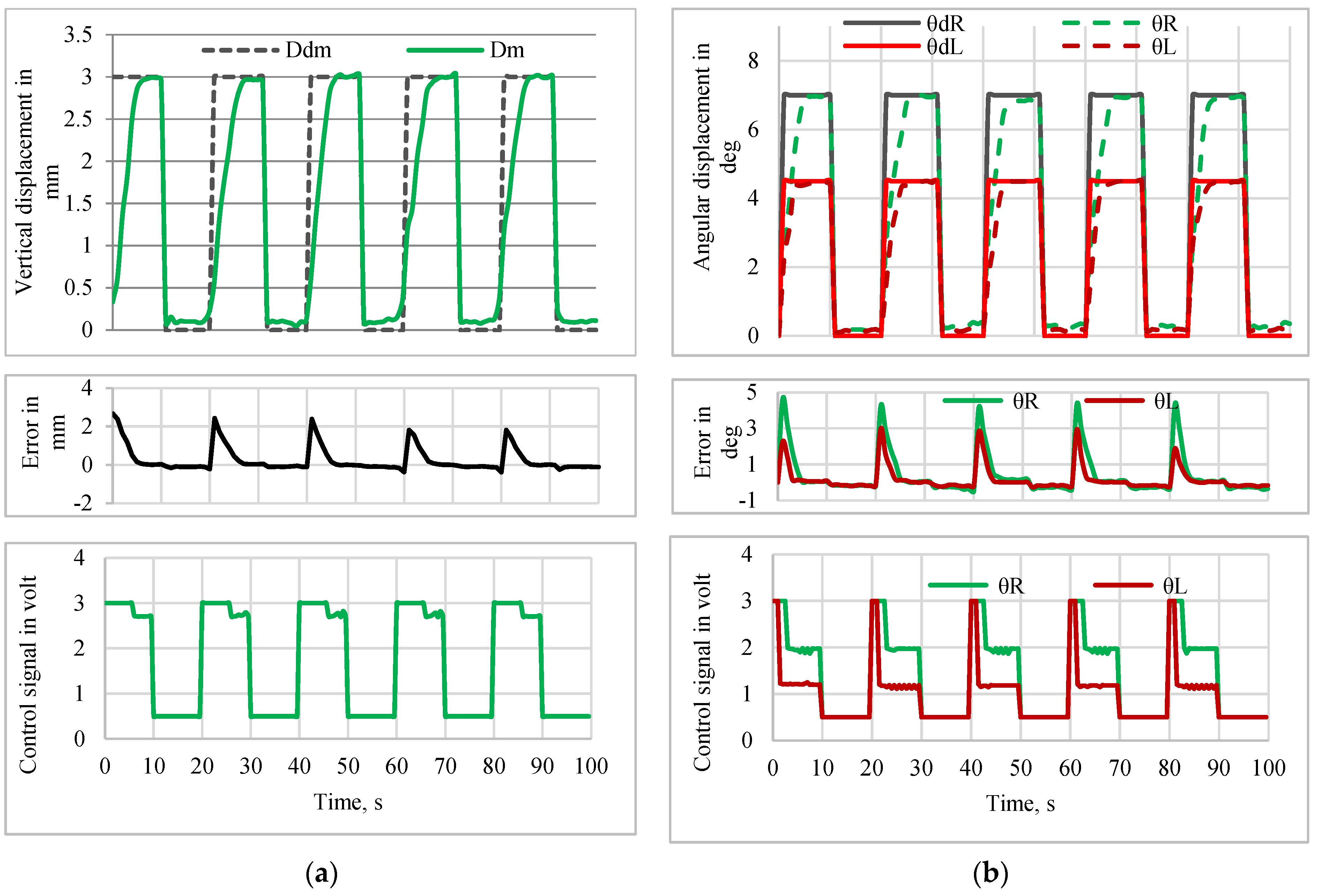




| Property | Value | |
|---|---|---|
| SMPICs 1 and 2 | Mirror | |
| Thickness | 76.75 μm (Kapton—75 μm + SMA—1.75 μm) | 100 μm |
| Length | 50 mm | 30 mm |
| Width | 20 mm | 20 mm |
| Input Voltage (V) | Dm (mm) | θL (deg) | θR (deg) | RS1 (ohm) | RS2 (ohm) |
|---|---|---|---|---|---|
| 0.00 | 0.00 | 0.00 | 0.00 | 6.50 | 6.50 |
| 1.00 | 0.32 | 1.15 | 0.94 | 6.49 | 6.48 |
| 1.50 | 0.62 | 1.80 | 1.71 | 6.44 | 6.40 |
| 2.00 | 1.49 | 4.68 | 4.20 | 5.92 | 5.87 |
| 2.25 | 1.78 | 6.07 | 5.72 | 5.76 | 5.70 |
| 2.50 | 2.42 | 7.97 | 7.75 | 5.43 | 5.44 |
| 2.75 | 2.90 | 9.33 | 9.10 | 5.18 | 5.16 |
| 3.00 | 3.37 | 10.84 | 9.95 | 4.99 | 5.01 |
| Input Frequency (Hz) | Dm (mm) | θL (deg) | θR (deg) | RS1 (ohm) | RS2 (ohm) |
|---|---|---|---|---|---|
| 0.05 | 3.39 | 9.75 | 9.72 | 4.98 | 4.98 |
| 0.10 | 3.21 | 9.26 | 9.21 | 5.09 | 5.08 |
| 0.20 | 2.56 | 7.28 | 7.36 | 5.37 | 5.35 |
| 0.33 | 1.70 | 4.63 | 4.78 | 5.78 | 5.77 |
| 0.50 | 0.99 | 2.67 | 2.66 | 6.22 | 6.20 |
Disclaimer/Publisher’s Note: The statements, opinions and data contained in all publications are solely those of the individual author(s) and contributor(s) and not of MDPI and/or the editor(s). MDPI and/or the editor(s) disclaim responsibility for any injury to people or property resulting from any ideas, methods, instructions or products referred to in the content. |
© 2024 by the authors. Licensee MDPI, Basel, Switzerland. This article is an open access article distributed under the terms and conditions of the Creative Commons Attribution (CC BY) license (https://creativecommons.org/licenses/by/4.0/).
Share and Cite
Velusamy, V.; Kaliaperumal, D.; Choi, S.-B. Sensor-Less Control of Mirror Manipulator Using Shape Memory Polyimide Composite Actuator: Experimental Work. Sensors 2024, 24, 3910. https://doi.org/10.3390/s24123910
Velusamy V, Kaliaperumal D, Choi S-B. Sensor-Less Control of Mirror Manipulator Using Shape Memory Polyimide Composite Actuator: Experimental Work. Sensors. 2024; 24(12):3910. https://doi.org/10.3390/s24123910
Chicago/Turabian StyleVelusamy, Vetriselvi, Dhanalakshmi Kaliaperumal, and Seung-Bok Choi. 2024. "Sensor-Less Control of Mirror Manipulator Using Shape Memory Polyimide Composite Actuator: Experimental Work" Sensors 24, no. 12: 3910. https://doi.org/10.3390/s24123910







